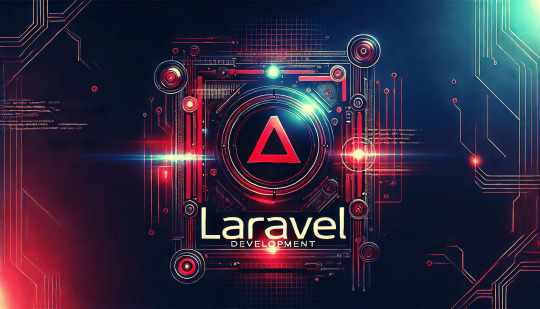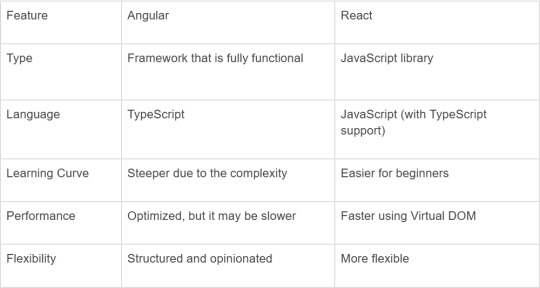#Next.js vs React
Explore tagged Tumblr posts
Text
What is Next.js vs Nest.js?

Next.js is a React framework for building server-side rendered and static web applications. Nest.js is a Node.js framework focused on building scalable, maintainable backend applications. While Next.js is for front-end, Nest.js specializes in backend architecture.
For more information read our blog: https://www.bitcot.com/nestjs-vs-nextjs/
0 notes
Text

How to Use Laravel with React, Vue, or Next.js?
Learn how to build modern, interactive web applications by integrating Laravel with React, Vue, or Next.js
#How to Use Laravel with Vue#laravel next.js#laravel vs nextjs#laravel vs react#How to Use Laravel with Next.js#hire expert laravel developer#hire Laravel Developer
0 notes
Text
Next.js can improve performance and SEO and allows you to render React components on the server-side before sending them to the client. React offers a declarative programming model that lets them specify how the user interface should look at any given time.
0 notes
Text
Next JS vs React: Which Framework to Choose for Optimal Frontend in 2024.

Read more Blogs,
Visit Website, Glasier Inc.
ReactJS development company
Hire Reactjs developers
Hire SaaS developers
Hire Android app developers
Hire IOS developers
#react js vs next js#next vs react#hire react js developers#hire dedicated developers#hire android developers#hire ios developers#react js development company#mobile app development company#ios app development services#custom software development company#custom software development
2 notes
·
View notes
Text
Unravel the intricacies of Next.js and React, two of the most prominent players in the world of front-end development.
Discover their strengths, use cases, and find out which one could be the ideal choice for your next project.
Stay ahead in 2024's web development landscape with this comprehensive comparison.
2 notes
·
View notes
Link
0 notes
Text

In the ever-evolving landscape of web development, Next js vs React is a debate that often surfaces among developers. Both are highly popular JavaScript technologies, but each serves a different purpose. React.js is a flexible library for building user interfaces, while Next.js is a powerful framework built on top of React.js that offers additional features like server-side rendering (SSR), static site generation (SSG), and more. Understanding the differences between Next js and React is essential for developers aiming to create high-performance, scalable web applications.
In this blog, we’ll break down the key differences between Next js vs React, and help you understand when and why to choose one over the other. By the end of this article, you’ll have a clear understanding of the use cases for both technologies and how they can be utilized to build modern web applications.
Next js is a React-based framework that facilitates building server-side rendered and static web applications. It provides features like server-side rendering (SSR), static site generation (SSG), and API routes out of the box. It is highly suitable for building SEO-friendly and performance-optimized applications.
0 notes
Text
Server Side Rendering vs Client Side Rendering

Server Side Rendering (SSR) and Client Side Rendering (CSR) are two popular techniques in modern web development for delivering dynamic content to users. SSR involves rendering web pages on the server before sending them to the browser, offering faster initial load times and improved SEO performance. It's commonly used with frameworks like Next.js and Nuxt.js for optimized web applications. On the other hand, CSR renders content directly in the browser using JavaScript, providing smoother user interactions and faster subsequent page loads. Frameworks like React, Angular, and Vue.js often use CSR to build single-page applications (SPAs). Choosing between SSR and CSR depends on your app’s goals—SSR is ideal for SEO-driven websites, while CSR excels in interactive user experiences.
0 notes
Text
React vs. Other Frameworks: Why Developers Prefer React
Introduction to React Popularity
In recent years, React has become the go-to framework for web developers across the globe. Whether building dynamic user interfaces or crafting responsive web applications, React consistently stands out. Many aspiring developers looking for the best React training in Hyderabad often begin their journey by understanding why React holds such a strong position in the industry.
Component-Based Architecture
Component-based structure is one of the biggest advantages of React.This allows developers to break down complex UIs into smaller, reusable pieces, making both development and maintenance easier. Other frameworks like Angular and Vue offer similar capabilities, but React’s simplicity and flexibility make it particularly appealing.
Strong Community Support and Ecosystem
The React framework is backed by Meta (formerly Facebook), and there is a massive global community involved with it.This ensures regular updates, extensive libraries, and a wealth of tutorials and tools that make development faster and more efficient. Compared to lesser-known frameworks, React provides a more reliable and scalable ecosystem.
Performance and SEO Benefits
React's virtual DOM optimizes rendering and improves performance, especially for dynamic applications. Additionally, with server-side rendering (using tools like Next.js), React can be SEO-friendly—an edge over some other frameworks that struggle with search engine visibility.
Conclusion
Choosing the right framework depends on your project needs, but React’s ease of use, performance, and support make it a top choice for modern developers. If you're ready to kick-start your journey with the most in-demand skills, consider enrolling at SSSIT Computer Education, known for offering expert-led, hands-on React training that prepares you for real-world success.
#best react training in Hyderabad#best react training in kukatpally#best react training in KPHB#best react training institute in Hyderabad
0 notes
Text
Why Headless Laravel CMS is Taking Over Traditional Web Development

Hey folks! 🚀 If you’ve been keeping up with web development trends, you’ve probably heard the buzz about headless Laravel CMS. It’s revolutionizing how we build and manage websites, leaving traditional CMS platforms like WordPress and Drupal in the dust. But why? Let’s dive in and explore why businesses and developers are making the switch—spoiler alert: it’s all about flexibility, speed, and scalability!
Understanding Headless Laravel CMS and Its Growing Popularity
A headless CMS isn’t some futuristic tech—it’s a smarter way to manage content. Unlike traditional CMS platforms that bundle the frontend and backend together, a headless CMS decouples them, giving developers the freedom to use any frontend framework while Laravel handles the backend like a pro.
What is a Headless CMS and How Does It Work?
Imagine a restaurant where the kitchen (backend) and dining area (frontend) operate independently. 🍽️ The kitchen prepares the food (content), and the waitstaff (APIs) deliver it to any dining setup—be it a food truck, rooftop café, or home delivery. That’s how a headless CMS works! It stores and manages content, then delivers it via APIs to any device or platform—websites, mobile apps, smartwatches, you name it.
Why Laravel is Perfect for a Headless CMS
Laravel isn’t just another PHP framework—it’s a powerhouse for API-driven development. With built-in support for RESTful and GraphQL APIs, Eloquent ORM for smooth database interactions, and a robust ecosystem, it’s no wonder Laravel is the top pick for headless CMS setups.
Headless Laravel CMS vs. Traditional CMS Solutions
Traditional CMS platforms like WordPress are great for simple websites, but they struggle with scalability and multi-channel content delivery. A headless Laravel CMS, on the other hand, offers:
No frontend restrictions (use React, Vue.js, or even a mobile app).
Better performance (no bloated themes or plugins slowing things down).
Future-proof flexibility (adapt to new tech without overhauling your backend).
Benefits of Using a Headless CMS with Laravel
Enhanced Performance and Scalability
Did you know? Websites using headless CMS architectures load up to 50% faster than traditional setups. 🏎️ By separating the frontend and backend, Laravel ensures your content is delivered lightning-fast, whether you’re serving 100 or 100,000 users.
Multi-Platform Content Delivery
With a headless Laravel CMS, your content isn’t tied to a single website. Publish once, and distribute everywhere—web, mobile apps, IoT devices, even digital billboards! Companies like Netflix and Spotify use headless CMS to deliver seamless experiences across platforms.
Improved Security and Backend Control
Traditional CMS platforms are hacker magnets (looking at you, WordPress plugins!). A headless Laravel CMS reduces vulnerabilities by:
Limiting exposure (no public-facing admin panel).
Using Laravel’s built-in security (CSRF protection, encryption).
Offering granular API access control.
Key Technologies Powering Headless Laravel CMS
RESTful and GraphQL APIs in Laravel CMS
Laravel makes API development a breeze. Whether you prefer REST (simple and structured) or GraphQL (flexible and efficient), Laravel’s got you covered. Fun fact: GraphQL can reduce API payloads by up to 70%, making your apps faster and more efficient.
Integrating Laravel CMS with JavaScript Frontend Frameworks
Pairing Laravel with React, Vue.js, or Next.js is like peanut butter and jelly—perfect together! 🥪 Frontend frameworks handle the UI, while Laravel manages data securely in the background. Many Laravel web development companies leverage this combo for high-performance apps.
Database and Storage Options for Headless Laravel CMS
Laravel plays nice with MySQL, PostgreSQL, MongoDB, and even cloud storage like AWS S3. Need to scale? No problem. Laravel’s database abstraction ensures smooth performance, whether you’re running a blog or a global e-commerce site.
Use Cases and Real-World Applications of Headless Laravel CMS
E-Commerce and Headless Laravel CMS
E-commerce giants love headless CMS for its agility. Imagine updating product listings once and seeing changes reflected instantly on your website, mobile app, and marketplace integrations. Companies like Nike and Adidas use headless setups for seamless shopping experiences.
Content-Heavy Websites and Laravel Headless CMS
News portals and media sites thrive with headless Laravel CMS. Why? Because journalists can publish content via a streamlined backend, while developers use modern frameworks to create dynamic, fast-loading frontends.
API-Driven Web and Mobile Applications
From fitness apps to banking platforms, headless Laravel CMS ensures real-time data sync across devices. No more clunky updates—just smooth, consistent user experiences.
Challenges and Best Practices for Headless Laravel CMS
Managing API Requests Efficiently
Too many API calls can slow things down. Solution? Caching and webhooks. Laravel’s caching mechanisms (Redis, Memcached) and event-driven webhooks keep performance snappy.
Handling SEO in a Headless Laravel CMS Setup
SEO isn’t dead—it’s just different! Use server-side rendering (SSR) with Next.js or Nuxt.js, and leverage Laravel’s meta-tag management tools to keep search engines happy.
Ensuring Smooth Frontend and Backend Communication
Clear API documentation and webhook integrations are key. A well-structured Laravel backend paired with a modular frontend ensures seamless updates and maintenance.
Final Thoughts
Headless Laravel CMS isn’t just a trend—it’s the future. With better performance, unmatched flexibility, and ironclad security, it’s no surprise that Laravel development companies are leading the charge. Whether you’re building an e-commerce platform, a content hub, or a multi-platform app, going headless with Laravel is a game-changer.
Key Takeaways
Headless Laravel CMS = Speed + Flexibility 🚀
API-first architecture = Content everywhere 📱💻
Security and scalability built-in 🔒
Frequently Asked Questions (FAQs)
1. What is the difference between a traditional CMS and a headless CMS?
A traditional CMS (like WordPress) combines the backend (content management) and frontend (display) in one system. A headless CMS decouples them, allowing content to be delivered via APIs to any frontend—websites, apps, or even smart devices. This offers greater flexibility and performance.
2. Why should I use Laravel for a headless CMS?
Laravel’s robust API support, security features, and scalability make it ideal for headless CMS setups. Its ecosystem (including tools like Laravel Sanctum for API auth) simplifies development, making it a top choice for Laravel web development services.
3. Can I integrate Laravel’s headless CMS with React or Vue.js?
Absolutely! Laravel works seamlessly with JavaScript frameworks like React, Vue.js, and Next.js. The backend serves content via APIs, while the frontend framework handles the UI, creating a fast, dynamic user experience.
4. How does a headless CMS improve website performance?
By separating the frontend and backend, a headless CMS reduces server load and eliminates bloated themes/plugins. Content is delivered via optimized APIs, resulting in faster load times and better scalability.
5. Is SEO more challenging in a headless CMS setup?
Not if you do it right! Use server-side rendering (SSR) with frameworks like Next.js, implement proper meta tags, and leverage Laravel’s SEO tools. Many headless CMS sites rank just as well—or better—than traditional ones.
There you have it, folks! 🎉 Headless Laravel CMS is reshaping web development, and now you know why. Ready to make the switch?
#headless Laravel CMS#headless CMS Laravel#Laravel API backend#Laravel content management#Laravel for headless websites#Laravel vs traditional CMS#modern web development Laravel#Laravel frontend frameworks#Laravel headless architecture#decoupled Laravel CMS
0 notes
Text
Crafting SEO-Friendly Websites: A Developer’s Roadmap to Visibility

In today’s digital ecosystem, a website’s success hinges not just on sleek design or functionality, but on its ability to be found. For developers, weaving SEO into the fabric of your build process isn’t optional—it’s critical. At CodingNectar.com, we’ve seen how SEO-savvy development drives traffic and growth. Let’s break down how to engineer websites that both users and search engines love.
1. Architect with SEO in Mind
A website’s structure is its backbone. Imagine constructing a skyscraper: without a blueprint, chaos ensues.
Flat Architecture Wins:
Keep pages within 3–4 clicks from the homepage for easy crawling.
Avoid orphan pages—every page should link back to your main navigation.
URLs That Speak Clearly:
Ditch cryptic strings like /page123. Opt for descriptive paths (e.g., /guides/seo-for-devs).
Use hyphens (-) to separate words—search engines read them as spaces.
Pro Tip: Tools like Screaming Frog act as X-ray goggles, uncovering broken links or duplicate content.
2. Nail Technical SEO Foundations
Think of technical SEO as the plumbing—it’s invisible but essential.
Mobile-First Isn’t a Trend, It’s a Rule:
Use responsive frameworks (e.g., Bootstrap) and test with Google’s Mobile-Friendly Tool.
Speed Is Non-Negotiable:
Compress images to WebP format (tools: ImageOptim).
Minify CSS/JS files and leverage browser caching.
Guide Search Engines:
Generate an XML sitemap.
Block irrelevant pages (e.g., test environments) via robots.txt.
3. Semantic HTML: SEO’s Best Friend
Clean code isn’t just for developers—it’s a love letter to search engines.
HTML5 Tags Are Your Allies:
Use <header>, <nav>, and <article> to add context.
Headings Hierarchy Matters:
One <h1> per page (your title), followed by logical <h2>-<h6>.
Alt Text: Describe, Don’t Keyword-Stuff:
alt="developer optimizing website speed" beats alt="SEO tips".
4. Ace Core Web Vitals
Google’s user experience metrics can make or break your rankings.
Largest Contentful Paint (LCP):
Target <2.5 seconds. Optimize hero images and lazy-load offscreen content.
First Input Delay (FID):
Defer non-critical JavaScript.
Cumulative Layout Shift (CLS):
Reserve image/video space with width and height attributes.
Test Tools: Google PageSpeed Insights and Lighthouse are your go-to auditors.
5. Content: Where Code Meets Strategy
Developers wear many hats—content strategist included.
Keyword Research:
Tools like Ahrefs uncover gems (e.g., “optimize Angular SEO” vs. generic terms).
SPA Challenges:
Use server-side rendering (Next.js/Nuxt.js) for React/Angular apps.
Canonical Tags:
Fix duplicate content with <link rel="canonical" href="https://your-primary-url">.
6. Security & Accessibility: SEO’s Silent Allies
HTTPS is Mandatory:
Free SSL via Let’s Encrypt boosts trust and rankings.
Accessibility Enhances SEO:
ARIA labels (e.g., aria-label="Contact form") aid screen readers and search bots.
7. Structured Data: Speak Google’s Language
Schema markup helps search engines “get” your content.
JSON-LD Example:
html
Copy<script type="application/ld+json"> { "@context": "https://schema.org", "@type": "Guide", "name": "SEO for Developers", "author": "CodingNectar.com" } </script> Run HTML
Validate with Google’s Structured Data Tool.
8. Monitor, Tweak, Repeat
SEO is a marathon, not a sprint.
Track Progress:
Google Search Console reveals crawl errors and keyword performance.
Moz or Ahrefs monitor rankings.
Fix Issues Promptly:
Redirect broken links (301s) and refresh stale content.
Avoid These SEO Blunders
Neglecting Mobile: Most searches happen on phones.
JavaScript Overload: Heavy scripts slow crawlers.
Duplicate Content: Canonical tags are your safety net.
Cheap Hosting: Slow servers = lost rankings.
Final Take: SEO is Part of Your Code
Building SEO-friendly sites isn’t about gaming algorithms—it’s about creating fast, accessible, and intuitive experiences. By embedding SEO into your development DNA, you’ll future-proof your work and unlock organic growth. At CodingNectar.com, we’ve turbocharged rankings for everyone from startups to Fortune 500s by merging technical rigor with SEO strategy.
Ready to code your way to the top? Start with SEO in your toolkit—your analytics will thank you.
0 notes
Text
Angular vs React: What to Choose in 2025?
With the constantly evolving web development landscape, selecting the best front-end framework is vital. Of the top options, Angular and React have been on the cutting edge for many years. Which one is the best option for 2025? Both have strengths and weak points, and the correct option will depend on your specific project's requirements. This article will discuss their advantages and disadvantages and other important aspects to take into consideration before making a choice.
What is Angular?
Angular is a fully-fledged front-end framework that was developed and is managed by Google. The framework is built on TypeScript. platform that is structured and has an opinionated method, which makes it an excellent choice for business-level applications.
What is React?
React in contrast is an JavaScript library that was developed by Facebook. It is mostly utilized to create interactive user interfaces that use components-based architecture. In contrast to Angular, React is more flexible and lets developers incorporate third-party libraries with ease.
Key Differences Between Angular and React

Advantages of Angular
Comprehensive Framework Angular offers everything you need to build sophisticated applications, including integrated route routing, dependency injection and form handling.
Two-Way Data Binding This feature makes sure that any change made in the user interface will be immediately visible in the model, and reversed.
Secure security: Angular offers built-in security features such as DOM Sanitization, which makes it a safe choice.
Business-Grade Service: The largest businesses are more likely to use Angular because of its structured approach and the support that is long-term from Google.
Modular Development Modular Development: The modular design aids in organizing code effectively, making huge projects easier to manage.
Advantages of React
Virtual DOM to speed up performance React makes use of a Virtual DOM that makes rendering quicker and faster.
React is a Component Based Architecture. It facilitates reuse, which makes development more efficient and more flexible.
Flexibility In contrast to Angular, React is less than a skeptic and allows developers to choose their own libraries and tools.
Strong Community and Ecosystem with a huge developers' community React provides extensive assistance from 3rd party vendors as well as a broad variety of libraries.
SEO-Friendly: React apps perform better in SEO since they can support Server-side rendering (SSR) with frameworks such as Next.js.
When to Choose Angular?
It is recommended to use Angular If:
You are creating a massive enterprise application that needs a structured framework.
Your project requires high security and robust built-in security features.
You like TypeScript and you require an unambiguous framework and guidelines.
You're looking for a comprehensive package that covers everything from state management to routing without having to rely on libraries from outside.
You are looking for an Angular Course to master TypeScript-based development with a well-structured framework.
When to Choose React?
React is a better option If:
You must design a light, fast and user-friendly interface.
You want a more flexible approach and would like the ability to combine and mix different third-party libraries.
Your project needs to be highly efficient thanks to React's virtual DOM.
You are creating an application with a single page (SPA) or a progressive web application (PWA).
You're looking to make use of the server-side rendering (SSR) using Next.js to improve SEO.
Final Verdict: Angular or React in 2025?
The two Angular and React both are effective in their own way. Your decision should be based on the needs of the project as well as the team's expertise and the long-term objectives.
If you're developing an extensive, complex system that has strict guidelines, Angular is the better choice.
If you require flexibility in your application, speed, and a flourishing ecosystem React is the best way to take.
The bottom line is that both technologies will continue to advance and being aware of the latest developments will allow you to make informed decisions for 2025 and beyond.
Which do you prefer? Let us know your thoughts in the comments below!
0 notes
Text
Debugging Common State Management Issues in Next.js Apps
Next.js has revolutionized web development, offering a powerful blend of React's component-based architecture and server-side rendering. However, as applications grow in complexity, managing state effectively becomes crucial. State management issues can lead to frustrating bugs, performance bottlenecks, and a poor user experience. This blog post explores common state management challenges in Next.js and provides practical debugging tips.
The Challenges of State in Next.js:
Next.js applications often combine client-side and server-side rendering. This hybrid approach, while powerful, introduces unique state management complexities.
Server-Side vs. Client-Side State: Understanding the distinction between state managed on the server during initial rendering and state managed on the client after hydration is essential. Mismatched state between these two environments can lead to hydration errors and unexpected behavior.
Data Fetching and Caching: Efficiently fetching and caching data, especially when dealing with APIs, is critical for performance. Inefficient data fetching can result in slow loading times and excessive network requests.
Component Communication: As applications scale, managing state across multiple components becomes challenging. Prop drilling and complex event handling can make code difficult to maintain and debug.
Global State Management: When dealing with shared state across the entire application, choosing the right global state management solution (e.g., Context API, Redux, Zustand) is crucial. Incorrect implementation can lead to performance issues and unpredictable state changes.
Debugging Strategies:
Here are some effective debugging techniques to tackle common state management issues in Next.js applications:
Leverage Browser Developer Tools:
Utilize the React Developer Tools extension to inspect component state and props.
Use the Network tab to monitor API requests and identify data fetching issues.
Employ the Console tab to track errors and warnings related to state updates.
Implement Logging and Debugging Statements:
Strategically place console.log() statements to track state changes and identify unexpected behavior.
Use conditional logging to narrow down specific issues.
Bugasura can help to organize and track these logs, and connect them to specific bugs.
Isolate Components:
Break down complex components into smaller, manageable pieces.
Test individual components in isolation to identify state-related issues.
This can be done using tools like Storybook.
Utilize React's Strict Mode:
Enable Strict Mode to identify potential issues during development, such as unsafe lifecycle methods and unexpected side effects.
This can catch many state related errors early in the development cycle.
Pay Attention to Hydration Errors:
Carefully examine hydration errors, as they often indicate discrepancies between server-side and client-side state.
Ensure that initial state values are consistent across both environments.
Test Thoroughly:
Write unit and integration tests to verify state behavior and prevent regressions.
Use testing libraries like Jest and React Testing Library to create comprehensive test suites.
Testing is a core part of confirming state management is working correctly.
Bugasura and State Management Debugging:
Bugasura can be an invaluable tool for debugging state management issues. By integrating Bugasura into your Next.js workflow, you can:
Capture detailed bug reports, including console logs, network requests, and component state.
Collaborate with team members to track and resolve state-related bugs efficiently.
Gain insights into recurring state management issues and improve your application's overall stability.
By understanding the common state management challenges in Next.js and employing effective debugging techniques, you can build robust and maintainable applications.
0 notes
Text
Yoooo.App vs. TSEscorts – Features, Pricing & User Experience Compared

The escort industry is evolving, and platforms like Yoooo.App and TSEscorts compete to provide the best services. For clients searching for Gigolo Service in Pune, Call Boys in Pune, and Playboy in Pune, platform reliability, verification, and escort variety are crucial. This comparison evaluates both platforms based on technology, market positioning, SEO performance, business strategies, and audience engagement to determine which is superior.
1. Tech Comparison: Performance, Security & Scalability
Feature
Yoooo.App
TSEscorts
Website Speed
🚀 Fast (Optimized for mobile & desktop)
🐢 Moderate (Lag issues on mobile)
Mobile-Friendly
✅ Fully Responsive
❌ Limited mobile optimization
Security & SSL
✅ Strong SSL encryption
✅ SSL secured
Technology Stack
Modern tech (React, Next.js)
Older framework
Scalability
✅ Scalable for global traffic
❌ Limited scalability
Accessibility
✅ WCAG-Compliant
❌ Limited accessibility features
📊
🏆 Winner: Yoooo.App due to faster speed, better mobile experience, and improved security.
2. Market Comparison: Branding & Differentiation
Factor
Yoooo.App
TSEscorts
Escort Categories
Male, Female, Trans, Gay
Female & Trans primarily
Global Coverage
🌍 Worldwide (Multiple cities)
📍 U.S.-focused
Branding
Premium, modern branding
Generic design
Platform Differentiation
Verified profiles, discreet bookings
Simple classified listings
Pricing & Monetization
Subscription-based & direct bookings
Ad-based revenue model

🏆 Winner: Yoooo.App for better branding, escort diversity, and global reach.
3. SEO Comparison: Visibility & Optimization
SEO Factor
Yoooo.App
TSEscorts
Domain Authority (DA)
45+
30+
On-Page SEO
✅ Optimized keywords, structured data
❌ Basic SEO
Backlinks
50k+ (High authority links)
20k+ (Moderate)
Content Strategy
Blogs, guides, escort profiles
Listings only
Technical SEO
✅ Sitemaps, canonical tags
❌ Basic setup
Targeted Keywords
Gigolo Service in Pune, Call Boys in Pune, Playboy in Pune, Male Escorts in Bengaluru, VIP escort bookings
Escort classifieds

🏆 Winner: Yoooo.App dominates in search engine visibility, backlink strength, and content strategy.
4. Business Comparison: Monetization & User Experience
Business Model
Yoooo.App
TSEscorts
Revenue Model
Subscription & bookings
Advertisements & listing fees
Conversion Rate
🔥 High (User-friendly UI)
❌ Moderate (Complex UI)
Customer Support
24/7 support, fast responses
Limited support
User Trust & Safety
✅ Verified escorts
❌ Unverified profiles
Payment Methods
Cards, crypto, bank transfer
Limited options
📊
🏆 Winner: Yoooo.App offers a more secure, user-friendly, and profitable business model.
5. Audience Comparison: Engagement & Demographics
Metric
Yoooo.App
TSEscorts
Monthly Visitors
1M+
500K+
User Engagement
🚀 High
Moderate
Traffic Sources
Organic, direct, paid ads
Classified traffic
Social Media Presence
Instagram, Twitter, Telegram
Minimal presence
User Ratings
⭐⭐⭐⭐⭐ (4.9)
⭐⭐⭐ (3.5)
📊
🏆 Winner: Yoooo.App attracts a larger audience with better engagement and marketing strategies.
Join Yoooo.App Today! 🚀
If you're looking for the best escort experience with verified profiles, seamless bookings, and top-tier security, Join Yoooo.App today! Whether you're searching for Gigolo Service in Pune, Call Boys in Pune, or Playboy in Pune, Yoooo.App offers a premium escort experience with safety and discretion.
👉 Click Here to Join Yoooo.App Now
0 notes
Text
JavaScript SEO: How to Make Your JS Website Search-Friendly
JavaScript is a powerful tool for creating dynamic, interactive websites. However, when it comes to SEO, JavaScript-heavy sites can pose significant challenges. If search engines can’t properly crawl, render, and index your content, your website’s visibility will suffer. That’s why JavaScript SEO is crucial for ensuring your site gets the organic traffic it deserves.
In this guide, we’ll explore how to optimize JavaScript websites for SEO and how an SEO agency can help improve search visibility.
Why JavaScript SEO Matters
Unlike traditional HTML-based websites, JavaScript websites require Googlebot and other search engines to execute scripts before they can see the content. If search engines struggle with rendering your pages, critical content may remain invisible to Google, leading to poor rankings.
By optimizing JavaScript for SEO, you can: ✔ Ensure your website is fully crawlable and indexable. ✔ Improve loading speed and user experience. ✔ Boost organic visibility and increase traffic.
How Search Engines Handle JavaScript
Search engines follow a three-step process to understand JavaScript-based pages:
Crawling – Googlebot discovers JavaScript pages by following links.
Rendering – The search engine executes JavaScript to load content.
Indexing – The processed content is added to Google’s index.
The problem? Rendering JavaScript takes extra time and resources compared to regular HTML, causing delays in indexing. If your pages don’t get indexed, they won’t rank on Google.
Best Practices to Make JavaScript Websites Search-Friendly
1. Use Server-Side Rendering (SSR) or Pre-Rendering
One of the biggest challenges with JavaScript SEO is that search engines may struggle to render your content. You can solve this by using:
Server-Side Rendering (SSR) – JavaScript is executed on the server before delivering fully rendered pages to users and search engines. This ensures faster load times and better crawlability.
Pre-rendering – This technique generates static HTML snapshots of your pages, which search engines can easily index.
💡 Frameworks like Next.js (for React) and Nuxt.js (for Vue.js) offer built-in SSR support.
2. Implement Dynamic Rendering for Large JavaScript Websites
If you run a large e-commerce or content-heavy website, consider dynamic rendering. This method serves a static HTML version to search engines while providing the JavaScript experience to users.
Google supports dynamic rendering, and it’s an effective way to ensure search bots can crawl and index your pages properly.
3. Optimize Internal Linking for Better Crawlability
JavaScript websites often rely on dynamic links, which Googlebot may not follow. Ensure that: ✅ Internal links use anchor tags (<a href>) instead of JavaScript-based event handlers like <button onclick>. ✅ Your XML sitemap includes all important URLs. ✅ A logical site structure helps search engines and users navigate your content easily.
💡 Pro Tip: Use Google Search Console to check if Google is properly discovering your internal links.
4. Improve Page Speed & Core Web Vitals
Google prioritizes fast-loading websites. If JavaScript slows down your site, users and search engines may struggle with it. Optimize your site by:
Minimizing JavaScript files using techniques like tree shaking and code splitting.
Lazy loading images and non-essential elements to reduce initial load time.
Using a CDN (Content Delivery Network) to serve JavaScript files faster.
💡 Test your site's performance with PageSpeed Insights and Lighthouse.
5. Ensure JavaScript Content Is Indexable
Googlebot might not index JavaScript content if it’s loaded dynamically after the page has already been crawled. To check if your content is visible to search engines:
✅ Use the Google Search Console URL Inspection Tool to see how Google renders your pages. ✅ Compare the raw HTML vs. rendered HTML to ensure important content is visible. ✅ Test with Google’s Mobile-Friendly Test to check mobile indexing issues.
6. Use Structured Data for Better Search Visibility
Structured data (Schema.org markup) helps search engines understand your content better and enhances your search appearance with rich results.
For JavaScript-based sites: ✔ Use JSON-LD schema markup (preferred by Google). ✔ Ensure the structured data is present in the rendered HTML, not just in JavaScript. ✔ Validate schema using Google’s Rich Results Test.
💡 Popular structured data types: Product, Article, FAQ, Breadcrumb, Local Business.
7. Monitor Crawl Errors and Fix Issues
To prevent crawl budget waste, regularly monitor your site for: 🚨 404 errors – Broken pages that prevent indexing. 🚨 Blocked resources – JavaScript files blocked in robots.txt. 🚨 Render-blocking scripts – Delays in loading critical content.
💡 Use Screaming Frog, Ahrefs, or Sitebulb to detect and fix technical SEO issues.
How an SEO Agency Can Help Optimize JavaScript SEO
JavaScript SEO can be complex, but an SEO agency specializing in technical SEO can help: 🔹 Conduct a JavaScript SEO audit to identify indexing and crawling issues. 🔹 Implement server-side rendering (SSR) or pre-rendering solutions. 🔹 Optimize JavaScript performance for faster page load times. 🔹 Fix internal linking and structured data for better search visibility.
If your JavaScript-heavy website isn’t ranking well, working with an SEO agency can ensure your content gets properly indexed and optimized for maximum organic reach.
Final Thoughts
JavaScript websites can be SEO-friendly if optimized correctly. By implementing server-side rendering, optimizing page speed, ensuring crawlability, and improving indexation, you can boost your rankings and improve search performance.
For businesses struggling with JavaScript SEO, partnering with eMarketing Egypt can make a huge difference in maximizing your website’s visibility and organic traffic. 🚀
0 notes